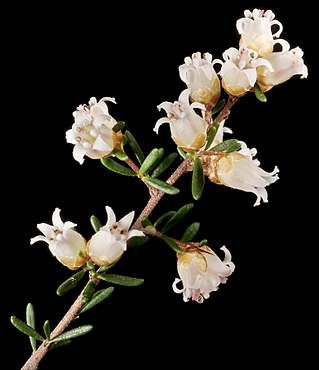
Cryptandra is a genus of flowering plants family Rhamnaceae and is endemic to Australia. Most plants in the genus Cryptandra are spiny, heath-like shrubs with small, clustered leaves and flowers crowded at the ends of branches, the flowers are usually small, surrounded by brown bracts, and with tube-shaped hypanthium, the petals hooded over the anthers.
Cryptandra apetala is a species of flowering plant in the family Rhamnaceae and is endemic to the south-west of Western Australia. It is a shrub with tufted, linear to lance-shaped leaves, and urn-shaped white to creamy-white and pink flowers arranged on short side shoots.
Cryptandra beverleyensis is a species of flowering plant in the family Rhamnaceae and is endemic to the southwest of Western Australia. It is a shrub with narrowly oblong leaves and clusters of white, tube-shaped flowers.
Cryptandra congesta is a flowering plant in the family Rhamnaceae and is endemic to a restricted area of the south-west of Western Australia. It is a low, spreading shrub with narrowly egg-shaped or narrowly oblong leaves and clusters of white, tube-shaped flowers.

Cryptandra connata is a species of flowering plant in the family Rhamnaceae and is endemic to inland Western Australia. It is an erect, prickly shrub with linear to lance-shaped leaves and clusters of white, pink or purple, tube-shaped flowers.
Cryptandra exserta is a flowering plant in the family Rhamnaceae and is endemic to inland Western Australia. It is a shrub with narrowly oblong leaves and clusters of white, tube-shaped flowers.
Stenanthemum bremerense is a species of flowering plant in the family Rhamnaceae and is endemic to the southwest of Western Australia. It is an erect, or low spreading shrub with hairy young stems, broadly egg-shaped leaves and densely hairy heads of tube-shaped flowers, sometimes with whitish floral leaves.
Cryptandra imbricata is a flowering plant in the family Rhamnaceae and is endemic to the southwest of Western Australia. It is a spreading shrub with spiny, interlaced branchlets, narrowly oblong to linear leaves and spike-like clusters of white, tube-shaped flowers.
Cryptandra intermedia is a flowering plant in the family Rhamnaceae and is endemic to the southwest of Western Australia. It is a small shrub, usually with spiny branchlets, elliptic to linear leaves and spike-like clusters of white, tube-shaped flowers.
Cryptandra intonsa is a flowering plant in the family Rhamnaceae and is endemic to inland Western Australia. It is an erect or spreading shrub with linear to narrowly oblong leaves and white or cream-coloured, tube-shaped flowers arranged in head-like clusters.

Stenanthemum nanum is a species of flowering plant in the family Rhamnaceae and is endemic to the south-west of Western Australia. It is a prostrate shrub with hairy young stems, broadly egg-shaped leaves with the narrower end towards the base, and densely silvery-hairy heads of white or cream-coloured flowers.
Cryptandra minutifolia is a flowering plant in the family Rhamnaceae and is endemic to the south-west of Western Australia. It is a spreading shrub with oblong to elliptic leaves and clusters of white or pink, tube-shaped flowers.
Stenanthemum newbeyi is a species of flowering plant in the family Rhamnaceae and is endemic to a restricted area in the south of Western Australia. It is an erect or spreading shrub with hairy young stems, egg-shaped leaves with the narrower end towards the base, and clusters of rust-coloured, densely shaggy-hairy flowers, surrounded by whitish floral leaves.
Cryptandra monticola is a flowering plant in the family Rhamnaceae and is endemic to the south-west of Western Australia. It is an erect or spreading shrub with linear or narrowly oblong to elliptic leaves and head-like clusters of white, tube-shaped flowers.
Cryptandra nola is a flowering plant in the family Rhamnaceae and is endemic to the western region of Western Australia. It is an erect or spreading, spiny shrub with oblong to elliptic leaves and clusters of white, tube-shaped flowers.
Cryptandra pendula is a flowering plant in the family Rhamnaceae and is endemic to the southwest of Western Australia. It is a shrub with linear leaves and clusters of 5 to 15 pendulous, white, tube-shaped flowers.
Cryptandra polyclada is a species of flowering plant in the family Rhamnaceae and is endemic to the southwest of Western Australia. It is a low, spreading to mat-forming or erect shrub with white or cream-coloured, tube-shaped flowers. It was first formally described in 1904 by Ludwig Diels in Botanische Jahrbücher für Systematik, Pflanzengeschichte und Pflanzengeographie from specimens collected near Tammin. The specific epithet (polyclada) means "many shoots".

Cryptandra recurva is a flowering plant in the family Rhamnaceae and is endemic to Western Australia. It is an erect, spreading shrub with densely hairy young stems, narrowly oblong to narrowly egg-shaped leaves and clusters of white, cream-coloured or off-white, tube-shaped flowers.
Cryptandra stellulata is a flowering plant in the family Rhamnaceae and is endemic to the southwest of Western Australia. It is a shrub with spiny branches, narrowly oblong to linear leaves and spike-like clusters of 2 to 12 white, tube-shaped flowers.
Cryptandra wilsonii is a flowering plant in the family Rhamnaceae and is endemic to the south-west of Western Australia. It is a shrub with hairy young stems, oblong to narrowly oblong leaves and clusters of white, tube-shaped flowers arranged in small clusters.





